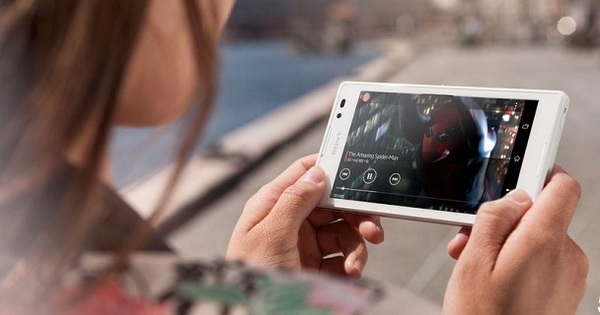Samsung released one of the best midrange devices of that time last year, when the Samsung Galaxy A50 appeared on the scene. The expectations for its successor, the Samsung Galaxy A51, are therefore high. Does the smartphone live up to those expectations? Read it in our Samsung Galaxy A51 review.
Samsung Galaxy A51
MSRP from € 269,-OS OS Android 10, OneUI2
Colors white, pink, blue
Screen 6.5 inch super amoled (2400 x 1080)
Processor 2.3GHz octa-core (Exynos 9611)
RAM 4GB
Storage 128GB
Battery 4,000mAh
Camera 48, 32 and 12 and 5 megapixels (rear), 32 megapixels (front)
Connectivity 4G (LTE), Bluetooth 5.0, Wi-Fi, GPS, NFC
Format 15.8 x 7.4 x 0.79 cm
Weight 172 grams
Other Fingerprint scanner behind screen, usb-c, dualsim
8 Score 80
- Pros
- Beautiful and large amoled screen
- Design and software look fresh
- More storage space than predecessor
- Camera module
- Negatives
- Processor a bit slow
- No ip certificate
- Fingerprint reader not fast
- Shooting in the evening
Look and feel
Samsung has brought the design of the Samsung Galaxy A51 to the 2020 level that was necessary. We see a camera hole with a single front camera at the top of the large 6.5-inch amoled screen. The size of the chin is minimal and comparable to other Galaxy smartphones. The device has USB-C and a headphone connection, which we think is always welcome. On the back we find a rectangular module with no fewer than four cameras, so that at first glance it is not noticeable that you are dealing with a midrange device.
However, when you take hold of the Samsung Galaxy A51, that illusion breaks: you can feel from the plastic casing that it is not a high-end smartphone after all. That's not bad at all: the advantage of plastic is that the device is fairly robust. It will not break easily if it slips out of your hands, unlike the glass that is present on smartphones these days. In addition, it is light and comfortable in the hand. Our model has been given the blue color that looks very fresh, while the glossy finish fortunately does not make the appearance seem cheap.
You have to pay attention, because the Samsung Galaxy A51 does not have an IP certificate. This means that it cannot withstand water or dust. Those few raindrops will just survive; however, if you drop him in a puddle or container with water, it can soon be the end of the exercise. That's actually the biggest drawback of the case, one that you really should keep in mind.

Relatively slow processor
The Samsung Galaxy A51 is equipped with at least 4 GB of RAM and 128 GB of storage space. The amount of RAM is more than sufficient for Android and the OneUI, Samsung's own software shell. 128 GB may not seem like much, but you can still store more than enough photos and videos or install games and apps on it. If that's not enough, don't worry: you can use a micro SD card to expand the storage space.
The processor is only marginally better when placed next to the other device. There are four cores clocked at 2.3 GHz, while the other four are more energy efficient with a clock speed of 1.7 GHz. In practice, this means that you sometimes encounter some stuttering: it may be that browsing takes a little longer than you might be used to or that the system sometimes has a hard time with the command you give. Fortunately, you can (continue to) play many games in a high resolution. They are minor annoyances, but nothing more than that.
There is also a battery with a capacity of 4000 mAh, so you are assured of a long usage time. If you don't game too much on it, it will easily take you a day and a half to empty it. Charging is happy, thanks to the usb-c port, so happens. Unfortunately, wireless charging is not included.
Display and fingerprint scanner
Compared to its predecessor, the screen of the Samsung Galaxy A51 is slightly larger (6.4-inch compared to 6.5-inch) and that means that the device is slightly higher and narrower. The resolution is 2400 by 1080 pixels. On this screen you arrive at a pixel density of 404 pixels per inch (ppi), which is a pretty tight score (above 400 ppi is generally considered good). The image is very sharp, the colors are lively (you can set this yourself) and the viewing angle is good, which the device all owes to the fact that it has an AMOLED display.
The fingerprint scanner of the Samsung Galaxy A51 is integrated into the display. As a result, the device has the allure of a high-end smartphone, since this technology was the first to be introduced there. The scanner is similar to other Samsung fingerprint readers: they're generally reliable and accurate, but you'll need to re-apply your finger to the scanning area more than once. Your fingerprint is not always recognized immediately or very quickly.



Android 10 and OneUI 2.0
In recent months, Samsung has been a lot faster when it comes to software updates. And that is noticeable in the Samsung Galaxy A51, which is equipped with Android 10 and OneUI 2.0. This means that this midranger has access to the latest software versions earlier than, for example, the Samsung Galaxy S20 series, which shows that the South Korean company takes its role as a software developer and the market for midrange smartphones seriously. You can also count on two Android upgrades.
OneUI 2.0 is very user-friendly software with its heart in the right place. The software does not hide functions and makes setting up your phone easier than ever. In addition, you can (automatically) switch to a dark theme for your entire phone, which is very pleasant in the evening and handy for the battery. As far as we are concerned, Samsung has invested so much in OneUI in recent months that it is now one of the best Android software shells at the moment.
The biggest new change is the way of navigating. Previously you used the three buttons at the bottom of the screen, but now you can set everything to be based on movements (as we saw earlier on Pixel and OnePlus phones, for example). Swiping up from the bottom opens the app drawer and by swiping up again from the bottom and holding your thumb on the screen for a while, you open the view for recent apps. Swiping your thumb or finger from the side to the center will take you back one page within the app or interface.
Unfortunately, the two downsides of the Samsung software are also present here: you cannot disable voice assistant Bixby and the standard applications cannot be removed either. As a result, you may eventually end up with duplicate applications. Fortunately, you can hide some apps in the drawer, but that only partially solves the problem.

Rectangular camera module with four cameras
The rectangular camera module is completely new. This colossus consists of a 5-megapixel depth sensor, a 48-megapixel main camera, a 12-megapixel ultra-wide-angle lens and another 5-megapixel macro lens. Not only do you now shoot images in higher resolution compared to last year's model, you also get access to completely new lenses.
When you take pictures with the 48-megapixel main camera, you will notice how much detail and color is captured. For example, if you take a photo of an environment with a lot of grass, it is possible that you see many different colors of green. Other details in the area, such as a fence, some trees or perhaps animals, are decent and with enough detail. However, if you switch to the wide-angle lens, you will miss a lot of fine details. Yes, you are actually putting more in one photo, but the quality is generally slightly less. The colors look a bit more faded and the difference in color reproduction is immediately clear.

With the macro camera you can take beautiful photos with a simple push of a button. You can hold objects very close to the lens and let the phone do the work. The object in the foreground is then beautifully displayed, while the background is neatly blurred. Furthermore, we cannot recommend digital zooming, because the photos will deteriorate in quality quickly. The selfie camera also works as you would expect: you look beautiful on it, while the background is less sharp. It actually applies to all cameras that sufficient light must be present, otherwise details will disappear quickly, images will look a bit grainy and the colors will not come out well. That applies to the photographers, but also the video makers among us.
Furthermore, it is possible to shoot videos in 4K with the main camera of 48-megapixel, at thirty frames per second. The front camera allows you to shoot videos in 1080p. In both cases the quality looks clear and detailed and we see that colors are captured beautifully.






Samsung Galaxy A51 – conclusion
All in all, we can say that the Samsung Galaxy A51 has become a fine successor to one of the most fine midrangers of last year. Not only do you get a slightly larger screen, more storage space and more cameras, you also get immediate access to the most recent version of Android and the OneUI from Samsung.
However, there are also disadvantages to the smartphone. For example, it is very nice that we now have more cameras that unlock more possibilities, but without sufficient light those photos do not always come out very well. In addition, we notice that the processor sometimes leaves something to be desired (but you can't have everything in this segment) and we regret that there is no official IP certificate. The latter is still understandable, so that the costs and therefore the price can remain low.
At the bottom of the line, there remains a smartphone that has a good price-quality ratio if you look at the amoled screen and the headphone jack. Because while there are still some caveats, there is more than enough to love. If you want a cool, good smartphone for which you don't have to give up a holiday, then the Samsung Galaxy A51 is for you.

